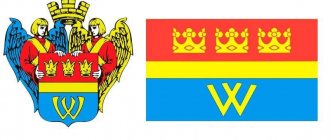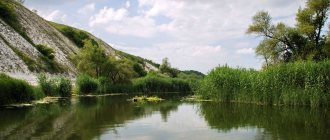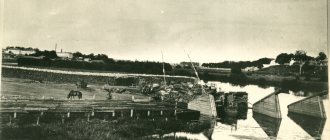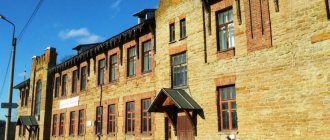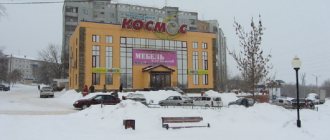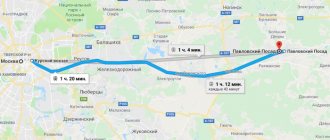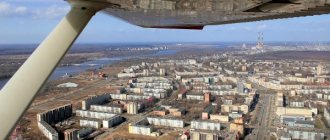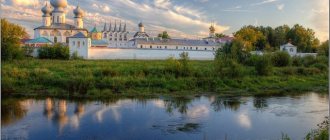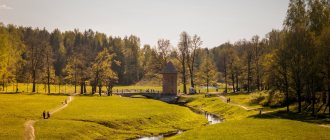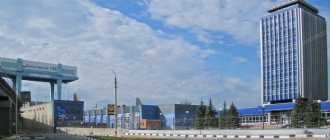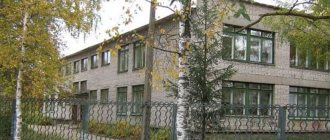One of the most picturesque cities in the Leningrad region is Vsevolozhsk. It arose on the site of a holiday village and a railway station built specifically for it. It received its name in honor of the founder Pavel Aleksandrovich Vsevolozhsky, who invested in the construction of the railway and became its shareholder. This place has always attracted St. Petersburg residents due to its nature, geographical location and special atmosphere. Pushkin visited here, the first cheese factory of Catherine II was once located here, during the Second World War the “Road of Life” passed through - the only thread connecting the mainland with besieged Leningrad. Today Vsevolozhsk is an attractive tourist route. The city has comfortable hotels and restaurants with interesting cuisine. There are few attractions in the city itself. They can be viewed in one day. The main value is natural areas. The city, like a hundred years ago, is one of the best vacation spots in the Leningrad region. From St. Petersburg there is an electric train from the Finlyandsky Station (Irinovskoe direction), minibuses from the Ladozhskaya and Ploshchad Lenina metro stations.
The city's attractions.
Since, it turns out, the city has quite a long and rich history, it, of course, has its own attractions: museums, architectural monuments and simply memorable places.
For example, in close proximity to the city there is the Priyutino estate - once its owner, A.N. Olenin, head of the Russian Academy of Arts, hosted the greatest representatives of our culture. Krylov, Venetsianov, Bryullov, Pushkin were here.
Now a museum exhibition is open here, and filmmakers often use the estate itself as a backdrop for filming. Vsevolozhsky’s manor house with a park has been preserved, only now it houses an agricultural technical school.
And the oldest existing building in the city is a cheese factory built in 1774, which was built on the initiative of the already mentioned Baron I. Yu. Fridriks.
There are also amazing ancient temples preserved in the city. The Church of the Savior Not Made by Hands and the Holy Trinity Church, for example, are considered architectural monuments of federal significance, and the Church of the Holy Trinity is a cultural and historical monument.
Relatively recently, several new churches were built: the Orthodox Church of St. Panteleimon (1996), the Orthodox Church of Saints Constantine and Helen (2001) and others.
There are several museums here: “Vsevolozhsk during the Siege”, the Museum of the History of Automobile Transport, and even the “Cat Museum”. Many memorials: “Rumbolovskaya Mountain” (part of the “Green Belt of Glory” monument complex), a monument to internationalist soldiers, liquidators of the Chernobyl nuclear power plant accident, soldiers who died in Chechnya, Heroes of the Second World War, the hero car - the “lorry”.
History of Vsevolozhsk in modern times
Vsevolozhsk officially became a city not so long ago - in 1963. In essence, this is a huge village, a conglomerate of ancient wooden and stone buildings, disfigured here and there by inclusions of Soviet five-story buildings, stalls and shops. In addition, there is a railway running right through the city. There are three stations in the city: Berngardovka, Vsevolozhskaya and Melnichny Ruchey (the old station building at Vsevolozhskaya is still preserved, but, despite the sign “Monument of Wooden Architecture of the 19th Century,” it is in terrible condition).
On the territory of the manor’s estate there are the Vsevolozhsk Agricultural College and an entire residential microdistrict. Of the original buildings of the estate, only a dilapidated stable, built of cobblestones (!), has survived.
Traces of the past are still visible: everywhere between the houses and along the city streets there are rows of spruce and pine trees; There are islands of birch, oak, and maple trees—the remains of someone’s backyard parks. Some architectural fragments of the “previous era” have also been preserved - for example, the house of the merchant Khomyakov on Station Square or the house of the merchant Sveshnikov; Not far from this place, the first Empire cinema was opened in 1912; in Soviet times there was a thrift store there.
Links[edit]
Notes[edit]
- ^ abcdefgh Area Law No. 32-oz.
- ^ a b Federal State Statistics Service (2011). All-Russian Population Census 2010. Volume 1 [All-Russian Population Census 2010, vol. 1]. All-Russian Population Census 2010 [All-Russian Population Census 2010] (in Russian). Federal State Statistics Service.
- "26. The size of the permanent population of the Russian Federation by municipalities as of January 1, 2022". Federal State Statistics Service. Retrieved January 23, 2022.
- ^ abcde Law No. 17-ounce
- "On the Calculation of Time". Official Internet portal of legal information
. June 3, 2011. Retrieved January 19, 2022. - Post office. Information and computing center of OASU RPO. ( Post office
).
Search for postal service objects ( postal Search for objects
) (in Russian) - ↑
Federal State Statistics Service of Russia (May 21, 2004). The population of the Russian Federation, cities of the Russian Federation as part of federal districts, urban settlements, settlements, settlements, settlements is 3 thousand or more people. [Population of Russia, its federal districts , subjects of the Federation, districts, urban settlements, rural settlements - administrative centers and rural settlements with a population of more than 3000 people] (XLS). All-Russian Population Census of 2002 [All-Russian Population Census of 2002] (in Russian). - All-Union Population Census of 1989 Population of Union and Autonomous Republics, Autonomous Regions and Districts, Territories, Regions, Urban Settlements and Village District Centers [All-Union Population Census of 1989: Current Population of Union and Autonomous Republics, Autonomous Regions and Districts, Territories, Regions , districts, urban settlements and villages performing the functions of district administrative centers]. All-Union Population Census of 1989 [All-Union Population Census of 1989] (in Russian). Institute of Demography of the National Research University: Higher School of Economics [Institute of Demography of the National Research University: Higher School of Economics]. 1989 - via Demoscope Weekly
. - History (in Russian). Official website of the Municipal Municipality "City of Vsevolozhsk". Retrieved March 19, 2014.
- ^ a b Petrograd district (1917 - January 1924), Leningrad district (January 1924 - August 1927) (in Russian). System of classifiers of executive bodies of state power of St. Petersburg. Retrieved March 19, 2014.
- ^ a b c d Leninsky district of the Leningrad district (August 1927 - August 1930) (in Russian). System of classifiers of executive bodies of state power of St. Petersburg. Retrieved March 19, 2014.
- Leningrad region (in Russian). Handbook on the history of the Communist Party and the Soviet Union 1898 - 1991. Retrieved March 6, 2014.
- ^ a b Leningradsky Suburban District (August 1930 - August 1936) (in Russian). System of classifiers of executive bodies of state power of St. Petersburg. Retrieved March 19, 2014.
- ^ a b c Vsevolozhsk region (August 1936) (in Russian). System of classifiers of executive bodies of state power of St. Petersburg. Retrieved March 19, 2014.
- Report on the work of the committee for interaction with local government of the Leningrad region in 2010 (in Russian). Committee for Press and Public Relations of the Leningrad Region. Retrieved November 16, 2012.
- Monuments of history and culture of the peoples of the Russian Federation (in Russian). Ministry of Culture of Russia. Retrieved June 2, 2016.
- Vsevolozhsk State Museum of History and Local Lore (in Russian). Russian Cultural Heritage Network. Retrieved April 9, 2013.
- Literary and art museum-estate "Priyutino" (in Russian). Russian Cultural Heritage Network. Retrieved April 9, 2013.
Sources [edit]
- Legislative Assembly of the Leningrad Region. Regional Law No. 32-oz of June 15, 2010 “On the administrative-territorial structure of the Leningrad region and the procedure for changing it,” as amended. Regional Law No. 23-oz dated May 8, 2014 “On the merger of municipalities” Primorskoye urban settlement of the Vyborg district of the Leningrad region and Glebychevskoye rural settlement of the Vyborg district of the Leningrad region and on amendments to certain Regional laws. Came into force on the date of official publication. Published: “Vesti”, No. 112, June 23, 2010 (Legislative Assembly of the Leningrad Region. Regional Law of June 15, 2010 No. 32-oz “ On the administrative-territorial structure of the Leningrad Region and the procedure for changing it”
, As amended by the Regional Law dated 05/08/2014 No. 23-oz.
On the annexation of the municipalities "Urban settlement Primorskoye" in the Vyborg district of the Leningrad region and the "Glebychevskoye rural settlement" in the Vyborg district of the Leningrad region and on amendments to various regional laws
. Valid from the date of official publication.) . - Legislative Assembly of the Leningrad Region. Regional Law No. 17-oz of March 10, 2004 “On establishing boundaries and conferring statuses on the municipalities of Vsevolozhsk District and Vyborg District and the municipalities within them,” as amended. Regional Law No. 23-oz dated May 8, 2014 “On the merger of municipalities” Primorskoye urban settlement of the Vyborg district of the Leningrad region and Glebychevskoye rural settlement of the Vyborg district of the Leningrad region and on amendments to certain Regional laws. Came into force on the date of official publication. Published: “Vesti”, No. 27, March 11, 2004 (Legislative Assembly of the Leningrad Region. Regional Law No. 17-oz of March 10, 2004 On establishing boundaries and giving appropriate status to the municipalities of Vsevolozhsk and Vyborg districts and its constituent parts municipalities
as amended by Regional Law dated 05/08/2014 No. 23-oz “
On the annexation of the municipalities “Primorskoe urban settlement” in the Vyborg district of the Leningrad region and “Glebychevskoye rural settlement” in the Vyborg district of the Leningrad region and on amendments to various regional laws
. In force. from the date of official publication).
Epic legend of Vsevolozhsk
Back in 977, Prince Vladimir Svyatoslavich (the future Vladimir the Saint, who baptized Rus', aka the epic Vladimir the Red Sun) passed through these places. He walked (or rather, fled) with a small squad to Norway, to his ally - Jarl Hakon the Mighty, and he was then only about eighteen. In Norway and Sweden, Vladimir (together with the Novgorod governor Dobrynya) recruited a mercenary army and exactly three years later they triumphantly returned to Novgorod (again through the Ryabova manor or, in Finnish, Rääpüvä, as the Swedish chronicles also mention) . The further adventures of the prince are of little interest to us (although they are interesting in their own way: for example, the future holy prince lured his brother, Yaropolk, to negotiations, where two Varangians “raised him with swords under their bosoms,” and Vladimir took his brother’s pregnant wife, a former Greek nun into concubines). Much more interesting for us are the accomplishments of Vladimir’s son, Yaroslav the Wise, who in 1019 married the daughter of the Swedish king Olaf, Ingegerda. As a wedding gift from her husband, the Swede received possession of the “city of Aldeigaborg” (Old Ladoga) with adjacent lands, which have since received the name Ingria. It is easy to guess that the “Ryabov Manor” from the Swedish chronicles was included in the prince’s dowry (although the Russians did not seriously lay claim to these lands in those years).
Why is a small town attractive for living?
The city of Vsevolozhsk is the regional center of the Vsevolozhsk region, a small quiet city in the North-West of the Leningrad region. This is probably the most underrated suburb of St. Petersburg.
And it’s completely in vain, because it is fully worthy of the closest attention of those who are actively looking for new housing.
After all, this nice green city is located on the Karelian Isthmus, in the most picturesque places, surrounded by coniferous forests and clean lakes. And all this is very close to St. Petersburg, just about 7 kilometers away. But housing prices here compare favorably with those in St. Petersburg.
Unique nature
Whatever program you plan for yourself, you can be sure that Vsevolozhsk, the sights of which we looked at, will surprise you no less than any large city in Russia. Every person here will find something for themselves, something that is close to their heart. In addition to museums, memorials and temples, these places have incredibly beautiful nature, which you are unlikely to find anywhere else. The variety of colors that Vsevolozhsk is rich in is simply amazing. The attractions, the list of which is presented in the article, play an important role in this, but they are only part of everything that is so amazing in the city. For this reason, almost everyone who has ever been here wants to come back here again.
Population
| Population | |||||
| 2002[11] | 2006[12] | 2009[13] | 2010[14] | 2011[15] | 2012[16] |
| 45 530 | ↗46 100 | ↗48 287 | ↗60 018 | ↗60 135 | ↗60 642 |
| 2013[17] | 2014[18] | 2015[19] | 2016[20] | 2017[21] | 2018[22] |
| ↗62 390 | ↗64 598 | ↗66 480 | ↗68 147 | ↗70 523 | ↗73 126 |
| 2019[23] | 2020[24] | 2021[25] | |||
| ↗74 524 | ↗74 964 | ↗75 964 | |||
Ethnic composition of the Vsevolozhsk urban settlement according to the 2010 population census[26].
| № | Nationality | people |
| 1 | Azerbaijanis | 109 |
| 2 | Armenians | 607 |
| 3 | Bashkirs | 47 |
| 4 | Belarusians | 406 |
| 5 | Bulgarians | 8 |
| 6 | Buryats | 11 |
| 7 | Vepsians | 5 |
| 8 | Greeks | 4 |
| 9 | Georgians | 99 |
| 10 | Jews | 72 |
| 11 | Ingush | 6 |
| 12 | Kabardians | 10 |
| 13 | Kazakhs | 28 |
| 14 | Karelians | 19 |
| 15 | Kyrgyz | 48 |
| 16 | Komi | 9 |
| 17 | Koreans | 62 |
| 18 | Kumyks | 23 |
| 19 | Latvians | 9 |
| 20 | Lezgins | 21 |
| 21 | Lithuanians | 16 |
| 22 | Mari | 8 |
| 23 | Moldovans | 78 |
| 24 | Mordva | 28 |
| 25 | Germans | 35 |
| 26 | Ossetians | 21 |
| 27 | Poles | 19 |
| 28 | Russians | 54 432 |
| 29 | Tabasarans | 5 |
| 30 | Tajiks | 140 |
| 31 | Tatars | 323 |
| 32 | Turkmens | 10 |
| 33 | Udmurts | 6 |
| 34 | Uzbeks | 158 |
| 35 | Ukrainians | 1519 |
| 36 | Finns | 92 |
| 37 | Gypsies | 71 |
| 38 | Chechens | 4 |
| 39 | Chuvash | 30 |
| 40 | Estonians | 21 |
| 41 | Other nationalities | 31 |
| 42 | Didn't indicate nationality | 1354 |
| 43 | Total | 60 018 |
Administrative and municipal status[edit]
As part of its administrative divisions, Vsevolozhsk serves as the administrative center of Vsevolozhsk District. [1] Administratively, it, together with three rural settlements, is part of the Vsevolozhsky district as the municipal formation “
Vsevolozhskoye Village”
.
[1] As a municipal division, Vsevolozhskoye municipal settlements are included in the Vsevolozhsk municipal district as Vsevolozhskoye urban settlement
. [4]
